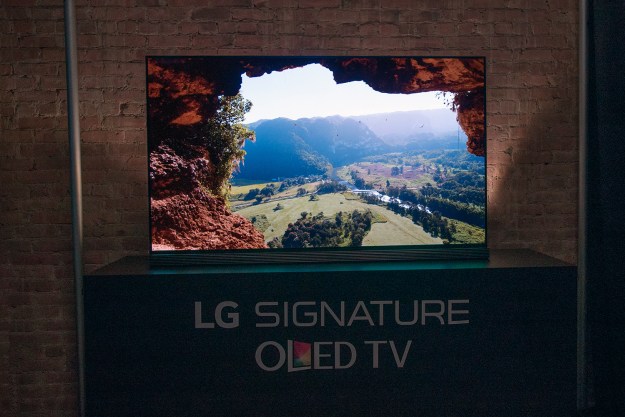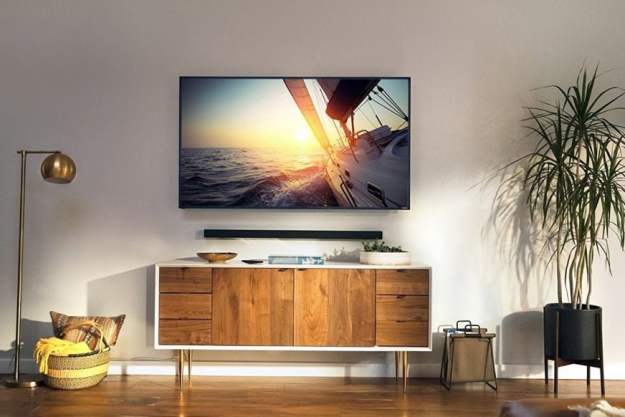
“No rival can touch the otherworldly picture quality of LG’s world-class Signature G6 OLED.”
- Perfect blacks and outstanding contrast
- Luscious, deep color
- HDR and Dolby Vision Capable
- Stunning design
- Ornate and expensive
The best TVs on the planet just got a whole lot better.
LG’s OLED TVs were so good last year, you might think they didn’t leave room for improvement. Not so. This year, every model in LG’s expanded OLED series is brighter and more colorful than before. What’s more, they are the first TVs to support both the open HDR 10 standard and Dolby Vision. No exaggeration: This is the best crop of TVs we’ve ever seen before, both in terms of features and performance.
For this review, our focus is on the Signature G6, LG’s OLED flagship. What makes it different than the models below it can be chalked up mostly to design elements, with some added punch in the audio department. In terms of picture quality, the TV has the same panel and processing you’ll find in the less expensive options, but all those techno-guts have been stuffed into a rather interesting sound bar structure, which doubles as the television’s base. This allows the G6’s panel to shine in all its thinner-than-your-smartphone glory. And it is pretty glorious.
In case you weren’t sure what you were seeing during LG’s confounding SuperBowl ad featuring Liam Neeson this year, it was the Signature G6, with its “picture on glass.” It’s hard to tell what LG was getting at in the commercial – it came off as cryptic to us, and we knew exactly what LG was doing — but it all makes perfect sense when you see the TV up close.
In short, it is just as much art as it is television, and it is absolutely one of the best TVs money can buy … by a mile. There’s not a single TV made today that can touch it – unless you count one of LG’s other OLEDs, that is.
It’s all about the design
All the major TV manufacturers are putting some serious effort into their industrial design this year, shooting it out to see who can come up with the thinnest, sexiest TV — Sony and Samsung in particular have created some incredibly thin LED/LCD TV models for 2016, as has LG. The only trouble is, the thinner an LCD panel gets, the harder it is to preserve picture performance. Samsung’s KS9500 is a good example of a TV we think might have given up a bit too much in the picture quality department for the sake of its waif-ish profile.
But with OLED, thinness and stunning picture quality are not mutually exclusive properties. LG knows this, and that’s why the G6 has been crafted to show off its figure in the most flattering way possible.
It begins with the TV’s base, which houses all the hardware and input connections at the back, while doubling as a 4.2-channel, 60-watt sound bar up front. If your plans are to wall mount, the base folds up behind the TV, with a second set of speakers which were once facing up, now facing out into the room. It adds a little bulk to the bottom of the TV, but the maximum amount of thin OLED panel remains exposed.
And by exposed, we mean set on a thin sheet of glass. That’s where the whole “picture on glass” thing comes in. Not only does the mounting method allow the OLED panel’s paper-thin thickness to be shown off, it also appears as a clear bezel. Take a close look at our video and you’ll see what we mean.
It’s a design bound to make friends and neighbors green with envy. Believe it.
Built better than before
LG’s OLED TV’s are brighter and more colorful than in prior years, optimizing them to meet the UHD Alliance’s requirements for its “UHD Premium” certification. That certification is generally intended to be a stamp conveying a premium UHD TV capable of HDR and Wide Color Gamut in addition to 3,840 x 2,160 pixel resolution, but LG’s OLEDs go a bit beyond that core sentiment.
Specifically, all of LG’s 2016 OLED TV’s can produce up to 99 percent of the DCI-P3 color space, and are capable of delivering not only HDR content under the
Videophiles may want to ask an increasingly common question at this point: How many nits?
I could watch this TV all day, every day, for the rest of my life.
For those unfamiliar, a nit is a unit of brightness, and a more common expression for cd/m2 (candelas per meter squared). These days, comparing nits is all the rage, and the direct answer for the question posed above is between 500 and 600 nits of peak brightness. But the expanded answer is: A high nit number doesn’t tell the whole story in the context of HDR performance when it comes to an OLED TV.
The reason? OLED TVs have perfect black levels, and therefore achieve contrast ratios an order of magnitude higher than TVs that boast 1,000 Nits peak brightness, but are incapable of deep black levels. That sounds a lot like LG’s marketing lines because it is. But it is also true. Contrast that begins at perfect black will always be considerably more striking than 1,000 nit peaks pitched against a milky-grey black level pocked with halos. If you’ve ever seen an OLED in action before, you already know this is true. Yet, the difference is even starker now that these TVs have gotten brighter.
But we’re just getting started. Now we need to talk about Dolby Vision.
Dolby Vision
Dolby Vision may be one of the least understood, most interesting movements in modern TV technology. With an “open standard” such as HDR 10 around, and the fact that Dolby is proprietary technology that must be licensed to be used, it might be easy to dismiss
The how and the why is pretty technical, but a very basic explanation is this: Dolby Vision-equipped TVs are capable of accepting a Dolby Vision HDR signal and interpreting it to match what the TV is capable of in terms of black level, color gamut, and peak brightness. The source material might ask the TV to produce a color outside its color or brightness range, for example, but the
Simply put, Dolby Vision looks better, and more like what filmmakers intended you to see. More than 100 popular titles are already available in
User experience
LG’s WebOS proceeds to version 3.0 this year, and ties with Samsung’s Tizen as our favorite smart TV interface. With the ability to add specific TV channels to the strip of tiles that pops up when you press the remote’s home key, WebOS makes surfing between TV channels and streaming services quite a bit easier.
New for WebOS 3.0 are a redesigned Magic Motion remote, Magic Zoom, and Magic Mobile Connection. The new Magic Motion remote now sports numerical keys and dedicated buttons for DVR control, making it rely less on on-screen controls than past models. Magic Zoom is a fun, if not particularly useful, feature which allows the user to zoom in extremely tight on anything on-screen (you’ll play with it for a while like a new toy, then forget it is there). More useful, however, is Magic Mobile Connection, which makes accessing content from a network-connected Android smartphone as simple as navigating the TV’s on-screen interface. Users can control which apps, photos, videos, and music can be accessed by the TV, lending a bit of needed security.
Overall, WebOS makes any LG TV a joy to use. It helps this one’s an OLED, though.
Picture quality
This is the first TV review I’ve ever conducted in which I didn’t employ the use of test patterns. Not a single one. I didn’t need to, because my subjective observations told me everything I needed to know.
I could watch this TV all day, every day, for the rest of my life.
I’m one of the pickiest people I know. Not neurotic, mind you, just very picky. I am aggravated by LED/LCD televisions and their backlight issues, probably more than is healthy for a person. I expect miracles when it comes to a TV’s reproduction of 24p movie content. And I want contrast that starts with true black, and ends at a brightness level where I’m never uncomfortable. Three years ago, I’d admitted to you I was asking for too much. But the G6 proves that is no longer the case. You can have a nearly perfect TV, and right now LG OLED is the best bet around. Period.
I’m going to buck convention and not attempt to describe with words how absolutely delicious this TV’s picture quality is. I feel like that would be a waste of your time. Instead, I’m going to encourage you to have some fun, hit the road, and go check this TV out in action at your local electronics store. Make sure you grab the remote and play around a bit (and be sure to turn off motion smoothing in the picture setting menu), then just sit back and marvel. And you will marvel. I don’t know a single person who has ever seen an OLED TV in person and not shaken their head in disbelief.
Frankly, there’s not enough hyperbole and superlatives in the world. I could use them all. Just go see it.
Now that I’ve shamelessly raved about the G6’s picture quality, let me address some concerns that may arise from reviews of previous OLED models.
There’s not a single TV made today that can touch it in terms of picture quality.
First, the “vignette effect” that caused the very outer edges of last year’s OLED panels to be ever-so-slightly dimmer than the rest of the screen? That’s been fixed. There is now no visible anomaly, and the edges appear just as bright as the rest of the panel.
Also, models from prior year used to crush shadow detail as the TV made a rather large stair step down from dark grey to black. LG also took care of that issue, and shadow details now look excellent.
Finally, my concerns about judder are placated. Yes, there is still some judder, and there always will be for as long as we’re playing back 24 frame-per-second content on a TV that relies on an 60-cycle-per-second electrical system. It’s just math. But, the judder is not as jarring as it was in years past. I noticed far less “flashing” than before, and now I’m perfectly comfortable with where LG’s OLEDS are at in terms of movie playback.
Conclusion
With those three issues now gone, the G6 is deadly close to a perfect 10 score. The reason it receives a 9 here instead is because LG will soon release a less expensive curved model (C6) and an even less expensive flat model , both with identical picture performance at a lower price. When the latter of those two comes in, we’ll break out the champagne and take a few days off to bask in its glory.
With that said, the G6 has its place as a flagship TV with both impeccable style and deep, deep substance. It even sounds surprisingly good. If you want a TV that’s as much a piece of art as it is a top-tier display, then the G6 is the best option available right now. And at $8,000 for the 65-inch model, it’s LG’s least expensive flagship OLED yet.
Editors' Recommendations
- Best Walmart TV deals: 43-inch 4K TV for $195 and more
- Best Buy TV deals: Save on QLED TVs, OLED TVs, and 8K TVs
- Samsung’s new 98-inch DU9000 4K TV is just $4,000. Can it beat TCL and Hisense?
- The 6 best OLED TVs for 2024
- LG TV deals: Get a 70-inch 4K TV for under $650










